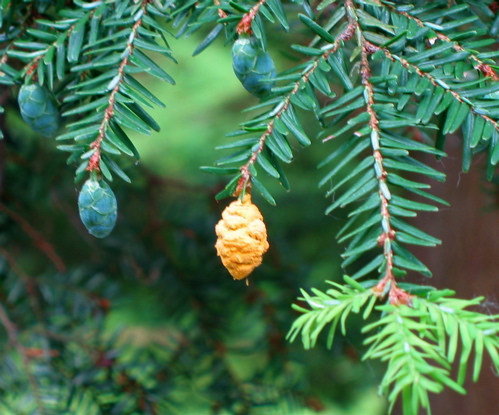Complementary Colors–Hemlock rust
 I am fortunate to live in a grove of hemlock trees by a babbling stream. A soft, blue-green hemlock light embraces me as I drive home in the evenings. In June, however, bright orange stars appear in the hemlocks. Amid the healthy turquoise hemlock cones, some wear a dense powdery coat of orange aeciospores.
I am fortunate to live in a grove of hemlock trees by a babbling stream. A soft, blue-green hemlock light embraces me as I drive home in the evenings. In June, however, bright orange stars appear in the hemlocks. Amid the healthy turquoise hemlock cones, some wear a dense powdery coat of orange aeciospores.
This fungus, Melampsora abietis-canadensis, is a fact of life here in the hemlock grove. If you’re reading this in Europe, you must be horrified. This is one of a handful of rusts that are threats to foreign forestry. Not that hemlock is valuable for its timber, but poplars are, and poplars are the alternate hosts of this little rust fungus. Poplars are workhorses–fast growers that are planted around the world for pulp and paper. This rust is therefore a threat to the pulp and paper industry, especially overseas where it doesn’t yet occur.
At my place, the poplar culprit is a little ways downstream–a mature cottonwood near the bridge. This rust must complete its life cycle on a poplar, where it makes two different kinds of spores: urediniospores (photo below) and teliospores. The latter fall to the ground in Fall; in Spring they germinate to make basidiospores, which float on the breeze to reinfect my hemlocks. Without both hosts, this disease just wouldn’t happen.
 After many years of being a mycologist, I’m still incredulous that rusts exist. A fungus that needs two hosts and five different spore states to survive? (Five. I haven’t mentioned the pycniospores) For the life cycle of another ubiquitous rust, check out our Plant Clinic page on cedar-apple rust). Doesn’t that seem a bit too Rube Goldberg-ish? Despite their complicated lives, rusts are a huge and successful group of plant pathogenic fungi. Impressive.
After many years of being a mycologist, I’m still incredulous that rusts exist. A fungus that needs two hosts and five different spore states to survive? (Five. I haven’t mentioned the pycniospores) For the life cycle of another ubiquitous rust, check out our Plant Clinic page on cedar-apple rust). Doesn’t that seem a bit too Rube Goldberg-ish? Despite their complicated lives, rusts are a huge and successful group of plant pathogenic fungi. Impressive.
Sinclair, W. A., and H. H. Lyon. 2005, Diseases of trees and shrubs. Ithaca, NY, Cornell University Press. (I was lucky to learn from Wayne while a grad student here at Cornell. He is a humble encyclopedia of tree disease information. I’ve seldom known anyone so learned.)
Photos by Kathie Hodge
Comments Off on Complementary Colors–Hemlock rust

